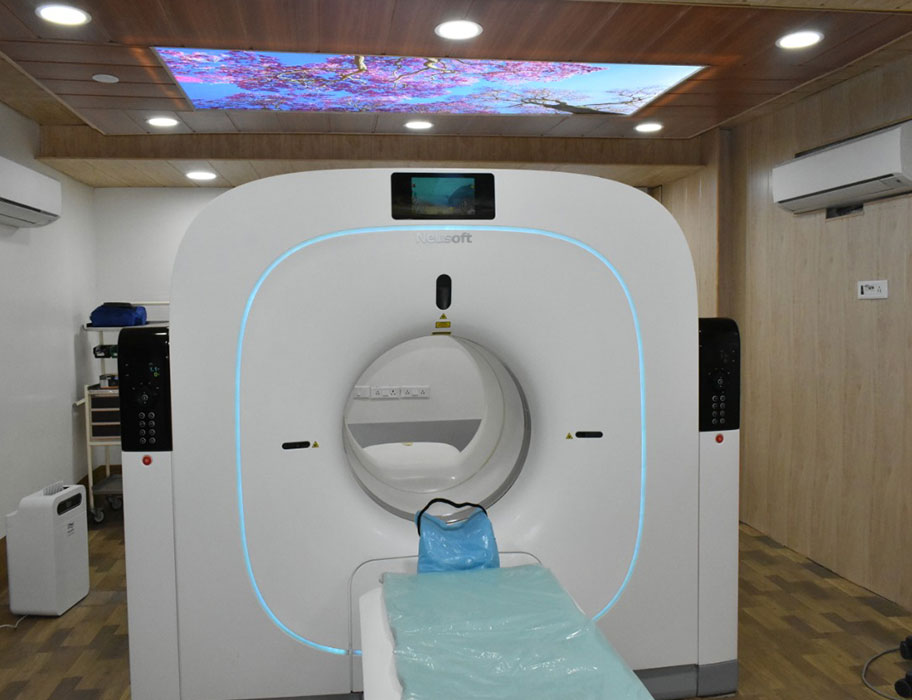
Information About PET CT Scan
-
What is PET-CT?
-
- PET-CT is a combination of two technologies : PET and computed tomography (CT), that produces highly detailed views of the body.
- These fusion imaging or hybrid imaging provide detail on both the anatomy and function of organs and tissues. This is accomplished by superimposing the precise location of abnormal metabolic activity (from PET) against the detailed anatomic image (from CT) in a single image.
-
-
How is PET- CT performed?
-
- Special preparation of patient is required before doing PET-CT
- The procedure begins with an intravenous (IV) injection of a radiotracer, such as FDG, which usually takes between 30 and 60 minutes to distribute throughout the body.
- The patient is then placed in the PET CT scanner where special detectors are used to create a three dimensional image of the FDG distribution. CT scan of patient is also taken in same position and used for image analysis.
- Scans are reviewed and interpreted by a nuclear medicine physician.
-
-
How does PET- CT work?
-
- Annihilation reaction: Radiopharmaceutical FDG is injected into vein. Once the FDG radiotracer accumulates in the body's tissues and organs, it emits positron that react with electrons in the body. This reaction, known as annihilation, produces energy in the form of a pair of photons. The PET scanner, which is able to detect these photons, creates three-dimensional images that show how the FDG is distributed in the area of the body being studied.
- Hot /cold spots: Depending on FDG accumulation hot spots or cold spots are identified. Using these images and the information they provide, physicians are able to evaluate how well organs and tissues are working and to detect abnormalities.
-
-
What is the role of PET- CT in cancer management ?
-
PET CT is used for diagnosing and determining the stage of many types of cancer, including lung, head and neck, colorectal, esophageal, lymphoma, melanoma, breast, thyroid, cervical, pancreatic and brain cancers.
It can be used for
Diagnose and stage: by determining the exact location of a tumor, the extent or stage of the disease. It tells uswhether the cancer has spread in the body. It also shows exact sites of spread.
Plan treatment: PET CT helps in selecting most effective therapy based on the unique molecular properties of the disease. It can avoid unnecessary surgery and morbidity related to it. So this is most cost effective tool in cancer care.
Evaluate the effectiveness of treatment: After start of chemotherapy/radiotherapy, PET-CT can help determine patient's response to these expensive therapies. Based on changes in cellular activity observed on PET-CT images, treatment plans can be quickly altered
Manage ongoing care: by detecting the recurrence of cancer and in long term surveillance.
-
-
Can PET-CT be used for diseases other than cancer?
-
PET is used in also used for detecting brain disorders, heart conditions and other diseases:
Brain Disorders
- PET scans are able to detect the early onset of neurological disorders such as Alzheimer's disease
- PET is frequently used to identify areas of the brain causing epileptic seizures as part of an evaluation of surgery as a treatment option.
Heart Conditions
- By differentiating normal and scarred heart muscle and pinpointing areas of decreased blood flow, PET scans are able to assist physicians in assessing the extent of coronary artery disease
- Information provided by PET scans can help in guiding effective treatment option to cardiologist such as angioplasty or coronary artery bypass surgery. It can tell whether patient will benefit from surgery or not. This can prevent unnecessary operations.
-

